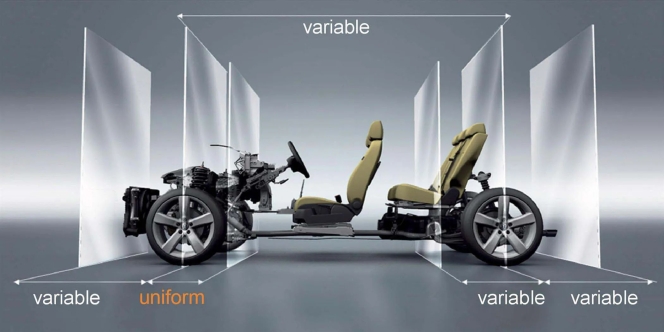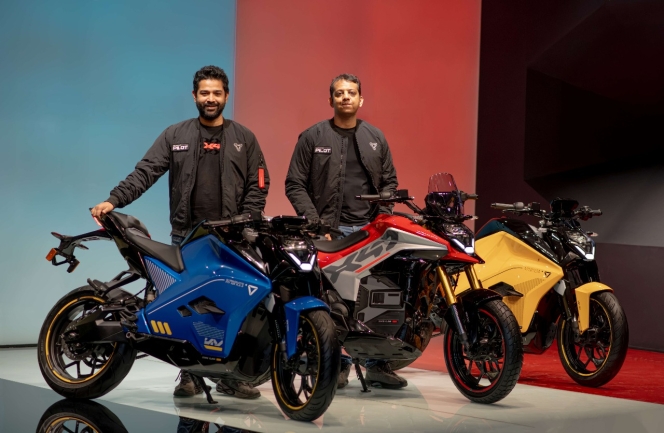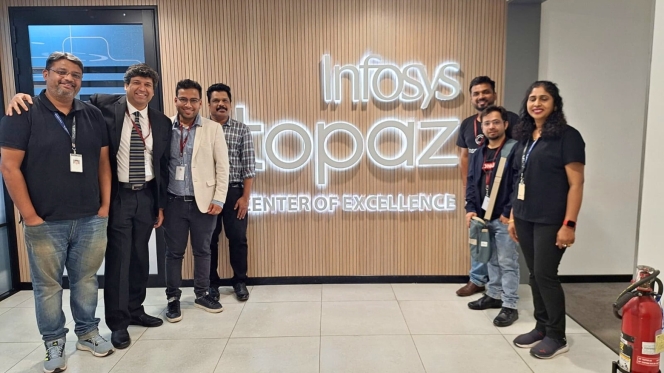Modular Automotive Architectures Are Flavours Of The Day
- By Bhushan Mhapralkar
- August 31, 2023

Factors such as ‘time-to-market’, regulations and costs are tilting the tables in the direction of modular vehicle architecture. This includes the design and assembly of all sub-systems of a vehicle in a modular manner. This also includes design standardisation and that of the production of auto parts in the form of modules.
The advantage of modular vehicle architecture can be clearly seen at the final 'assembly' stage were numerous variants (read as trims) can be positioned seamlessly and without bringing an entire operation to the halt for the want of a module, part of an assembly tool.
While the first instance of the employment of modular vehicle architecture in India may be hard to pin point, it was Ashok Leyland that announced the launch of a modular architecture in the form of the medium and heavy-duty AVTR truck platform as the BS VI emission norms came into effect in 2020.
The move reminded of the comprehensive modular architecture approach of Swedish truck maker Scania. The kind of modularity Scania built into its trucks was such that its customers could choose from a wide range of aggregates such as engines, transmissions, chassis, cabin and more to build a truck that would best address their application requirements.
Unlike the Scania’s approach to modularity, Ashok Leyland chose to offer its truck buyers the choice of engines, transmissions, suspensions, cabins and superstructure so that they could build a vehicle that met their business needs.
One of the key reasons why Ashok Leyland chose to go down the modular architecture route was the need to cut down on components such as the exhaust parts. There would have been parts that the company would have to produce in many numbers and types to address the customer requirements in the BS VI era had it not taken to the modular approach.
Not only did the AVTR modular architecture helped streamline the supply chain and control the costs better, it made sure the buyer of an Ashok Leyland medium or heavy-duty truck could choose from more than 600,000 unique combinations.
Like Ashok Leyland, Tata Motors has also been quite active in design and development of modular architectures. It developed the modular truck architecture in the form of the Prima many years ago along with its Korean Daewoo commercial vehicle arm. Not limiting itself to the Prima, the company developed modular architectures in the form of the Signa and Ultra.
It was the modular approach that led to the creation of some brilliant models such at the Signa 3118 and the Ultra 3118.
On the passenger vehicle side, the ‘ALFA’ modular architecture is being put to good use by Tata Motors in reducing the time to market and in controlling the costs as it competes with some of the most agile global passenger vehicle manufacturers in its home market as well as other markets in the world.
The ‘ALFA’ modular vehicle architecture is currently supporting the Altroz and Punch. It is also the basis for the electric Punch that is expected to be launched soon in India.
Allowing a differentiated design approach and subsequently multiple body styles to meet the evolving aspirations of customers in the automotive market, the ‘ALFA modular architecture – termed as ‘Agile Light Flexible Advanced’ and basis for an exciting e 45X concept – is playing a crucial role in meeting the high-volume demand for an entire portfolio of cars at Tata Motors as of now.
The beauty of the ‘ALFA’ architecture is such that it could be used to create diverse vehicles with distinct body styles with a variety of powertrains (petrol, diesel, CNG and even electric), transmissions, drivelines, suspensions etc, mentioned a source. A combination of body styles, hardware and software could be deployed to offer the necessary attributes, he added.
Pointing at the recent introduction of Punch CNG with twin-cylinder CNG technology, he informed that the ‘ALFA’ modular architecture is helping to expand the scope of twin-cylinder CNC tech as much.
The differentiating factor of the technology is that it does not eat into the vehicle storage space. The vehicle body can receive necessary reinforcements to bear the additional weight of the cylinders. In the CNG Punch, the suspension too has been suitably strengthened to handle the additional weight.
Observing that the CNG Punch is just one part, the source said that the electric Punch would mean that the ‘ALFA’ modular vehicle architecture has truly come to age. Claimed to be undergoing advanced testing and validation, the electric Punch would further enhance Tata Motors’ lead in the electric passenger vehicle space. It is expected to be introduced by the end of this year or early next year.
The ambitions that Tata Motors has regarding its EV portfolio could be derived from the fact that on 29 August 2023 it announced a new brand identity TATA.ev for its EV business. It is aligned with Tata Motors' commitment towards sustainability and innovation.
EVs influence modular vehicle architectures
EVs are turning to be a big factor for the creation of modular platforms lately as they promise less complexities pertaining to platform engineering, keeping them to the bare minimum. Modular electric vehicle architectures are also enabling the development of core platforms with standardised design and production of auto parts in the form of modules and a streamlined as well as compact final 'assembly' as per the positioning of models.
The R&D and production costs, shortening the development cycle of new models, facilitating the unification of quality standards and improving the overall strength of products, modular electric vehicle architectures are enabling unique ‘oil-to-electricity’ transformations as well.
Dedicated modular electric vehicle architectures are enabling clever integration (read as badge engineering) across brands and as a part of the new cooperation strategies. With software defined vehicles the order of the day, electric vehicles especially, the tilt towards modular vehicle architecture is proving to be beneficial in terms of offering a differentiated user experience, to keep control over the supply chain and to keep control over the costs and to test and validate.
(Image for representation purpose only)
Neusoft And MapmyIndia Partner For Intelligent Mobility Solutions
- By MT Bureau
- December 06, 2025

Chinese technology company Neusoft Corporation and Mappls MapmyIndia have signed a Memorandum of Understanding (MoU) to leverage their strengths in software and data resources to collaborate deeply.
The companies will engage in joint technological development, ecosystem collaboration and resource integration to provide navigation products and intelligent mobility solutions tailored to localised needs in emerging markets such as Southeast Asia and India.
The partnership is a response to the fact that while global auto brands are expanding into Southeast Asia and India, they face challenges in these regions due to complex road conditions, unique traffic rules, extensive addressing systems and high localisation adaptation costs. These issues limit the ability of automakers to deliver a complete intelligent user experience.
Under the collaboration, Neusoft will adopt its OneCoreGo Global Intelligent Mobility Solution 6.0 Plus as the core technology carrier, deeply integrating MapmyIndia's map data, real-time traffic information and multi-dimensional value-added services. MapmyIndia is noted as the largest local mapping company in India, holding more than 90 percent market share in in-vehicle navigation.
The integration is intended to strengthen a full capability loop of ‘navigation + payment + interaction + connectivity + operations’.
Through API integration and technological convergence, the two parties will jointly develop navigation products and mobility solutions highly adapted to Southeast Asia, India and similar regional markets. These solutions will deliver precise route planning and real-time traffic guidance, address local user needs and continuously enhance product experience and scenario-based services. This will help automotive partners rapidly launch intelligent vehicle models with competitiveness in local markets.
The partnership enables Neusoft to combine the global end-to-end strengths of its solution with localised ecosystem resources, paving the ‘last mile’ for automakers entering the Southeast Asian and Indian markets and delivering comprehensive intelligent mobility experiences.
- Ultraviolette Automotive
- Zoho Corporation
- Lingotto
- F77
- X-47
- Shockwave
- Tesseract
- Narayan Subramaniam
- Niraj Rajmohan
Ultraviolette Secures $45 Million Growth Capital From Zoho And Lingotto
- By MT Bureau
- December 04, 2025

Bengaluru-based electric vehicle maker Ultraviolette Automotive has secured USD 45 million from Zoho Corporation and Lingotto, one of Europe's investment management companies as part of its ongoing Series E investment round.
The investment from Zoho Corporation was led by Sridhar Vembu, Mani Vembu and Kumar Vembu.
This growth capital will accelerate the domestic and international scale-up of current products F77 and X-47, as well as future product platforms Shockwave and Tesseract.
Ultraviolette has built a design and technology-led enterprise with the F77 and the recently launched X-47.
The company has expanded to 30 cities across India in a short span of 12 months and is expanding to 100 cities by mid-2026. The F77 motorcycles were recently launched in the United Kingdom, bringing Ultraviolette's presence to 12 countries across Europe.
Narayan Subramaniam, Co-Founder & CEO, Ultraviolette Automotive, said, “We are glad to announce our Series E investment from Zoho and Lingotto. Lingotto's legacy of backing iconic performance and mobility brands, combined with Zoho's long-term commitment to fostering cutting-edge Indian innovation, aligns perfectly with Ultraviolette's mission to build category-defining electric mobility solutions for India and global markets.”
Niraj Rajmohan, CTO & Co-Founder, Ultraviolette, said, "With the ongoing Series E investments, we are doubling down on growth and expanding our production to meet increasing demand. Our focus is on advancing breakthrough battery technology, elevating performance capabilities and expanding production to support upcoming product platforms. This investment will accelerate our journey towards scaling into India and global markets."
Disseqt AI Partners Tata Technologies And Infosys For Agentic AI Adoption
- By MT Bureau
- December 04, 2025

Agentic AI platform Disseqt AI has announced a partnership with Tata Technologies and Infosys. As per the agreement, Disseqt AI will assist both companies' IT and DevOps teams in developing and fast-tracking the production of tailored Agentic AI applications for automobile and FinTech companies globally.
The partnership aims to help auto and FinTech firms embrace customised Agentic AI faster and in a secure manner.
Disseqt AI, which has operations in Bengaluru, San Francisco and Dublin, provides an enterprise-grade platform for IT and DevOps teams. The company claims its platform cuts down Agentic AI testing and operations cost by 70 percent and improves productivity by up to 80 percent. The platform allows these teams to test, simulate and monitor their Agentic AI systems tailored across industries, ultimately enabling enterprises to operationalise tailored Agentic AI faster and at scale, without sacrificing ethics, governance and compliance.
Apoorva Kumar, Founder and CEO, Disseqt AI, said, “This is a landmark announcement for us as we further embed Disseqt into enterprise workflows for testing, simulation, monitoring and auditability purposes. We are already working closely with both Tata and Infosys on several projects and are proud to be part of their innovation initiatives”
Last month, Disseqt AI announced a strategic collaboration with HCLTech and Microsoft to guide financial services institutions with Agentic AI adoption.
Battery Passport Implementation Beyond EVs To Be Focus Of Barcelona Event
- By MT Bureau
- December 03, 2025

Battery and Energy Storage Europe has announced a programme focused on the EU Battery Passport, a regulatory milestone that becomes mandatory in February 2027. The Barcelona-based event will address the compliance gap for applications beyond the electric vehicle (EV) sector, which have dominated the conversation to date.
The event, taking place on 8th and 9th September 2026 at Fira de Barcelona's Gran Via venue, will focus on solutions and talks for applications that fall within the regulation's scope: stationary energy storage, industrial batteries, grid-scale systems, long-duration energy storage and emerging applications in aerospace, maritime and rail electrification.
With the February 2027 legal requirement date approaching, the programme will bring together industry leaders, technology providers, and policy experts to address the compliance challenges facing these diverse sectors.
The Battery Passport is a digital record documenting a battery's entire lifecycle, from raw material sourcing to production, performance and eventual recycling. From February 2027, it becomes mandatory for all rechargeable EV, industrial and LMT batteries over 2 kWh sold in the EU.
Linked via QR code, the passport will track each battery's complete lifecycle, including composition, carbon footprint and recycled content, fundamentally transforming supply chain transparency and sustainability practices across Europe.
The programme will explore implementation topics including digital infrastructure requirements, data management systems, supply chain integration, verification processes and recycling traceability.
Ken Davies, Conference Programme Director at Battery and Energy Storage Europe, said, "The Battery Passport represents one of the most significant regulatory shifts our industry has faced, yet many companies are still grappling with what implementation actually means for their operations. While the EV sector has dominated the conversation, there's a critical need to address how this regulation applies to stationary storage, industrial applications and the innovative battery technologies powering Europe's energy transition. With the clock ticking toward February 2027, Battery and Energy Storage Europe will shine a light on the practical implementation requirements for these often-overlooked sectors, connecting stakeholders with actionable solutions and bringing together the expertise, technology providers, and collaborative spirit needed to turn compliance into competitive advantage across the full spectrum of battery applications."





Comments (0)
ADD COMMENT